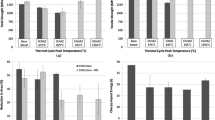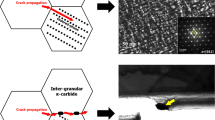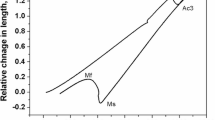Abstract
Investigations of microstructural and hardness gradients in the heat-affected zone (HAZ) of quenched and tempered (Q&T) steels have indicated that peak hardness does not occur in the grain-coarsened heat-affected zone (GCHAZ) adjacent to the fusion boundary, which is typical of ferritic steels, but corresponds more closely to the grain-refined region (GRHAZ). This phenomenon, the displaced hardness peak (DHP) effect, is considered to arise when the hardenability of the steel is high enough to result in the same microstructure in the GC and GR heat-affected zones, except for significant refinement of the microstructure of the GRHAZ, which increases the hardness and strength above those of the GCHAZ. The current paper concentrates on the effect of grain size on hardness in the HAZ of a boron-containing low-carbon martensitic steel subjected to bead-on-plate welding. Thermal simulation experiments were used to clarify the relationship between prior austenite grain size and the hardness gradients in the actual HAZ. The simulation work demonstrated that peak hardness in simulation samples occurred in regions of lower austenite grain size, supporting the proposed origin of the DHP effect in actual welds. Implications regarding hydrogen-induced cold cracking (HICC) susceptibility of the GRHAZ are discussed.












Similar content being viewed by others
References
(1964) The making, shaping and treating of steel: 8th Ed, USS Corp., Pitts., PA, 1092–3
Pang W, Ahmed N, Dunne D (2011) Hardness and microstructural gradients in the heat affected zone of welded low-carbon quenched and tempered steels. Australasian Weld J - WRS 56(2):36–48
(1967) International Institute of Welding, IIW Doc. IX-535-67
Dunne DP (1995) “Weldable copper strengthened low carbon steels”, Proceedings of HSLA’95 Conference, Beijing, Oct., 90–98
Pang W (1995) “The structure and properties of the heat affected zone of structural plate steels welded by high productivity processes”, Ph.D Thesis, University of Wollongong
Dunne DP, Pang W (2013) Structural and hardness gradients in the heat affected zone of welded low carbon martensitic steels. Mater Sci Forum 738-739:206–211
Dani SG (1993) “The effect of pre-heat on the structure and properties of the HAZ of a welded quenched and tempered steel plate”, Master of Engineering (Hons) Thesis, University of Wollongong
Guimelli A, Pang W, Hamilton G, Dunne D (1992) “Weld thermal cycle simulation using computer controlled resistance heating”, Pacrim Weldcon ‘92, Proc. 40th National Conf. of Welding Technology Institute of Australia, Vol. 2, WTIA, Darwin, Paper 45
(1992) Atlas for Bainitic Microstructures: Vol. 1, Bainite Committee of Iron and Steel Inst. of Japan
Liang Chen (2000) “Characterisation of transverse cold cracking in weld metal of a high strength quenched and tempered steel”, Ph.D Thesis, The University of Wollongong
Rosenthal D (1946) Trans ASME 68:167
Easterling K (1983) Introduction to the physical metallurgy of welding. Butterworths, London
Widgery DJ (1972) “The design and use of a resistance heated weld simulator”, Seminar Handbook, The Welding Institute, 15
Dunne D (1999) Ferrite morphology and residual phases in continuously cooled low carbon steels. Materials Forum 23:63–76
Pickering FB (1978) Physical metallurgy and the Design of Steels. App. Sci. Publishers Ltd, London
Grange RA (1966) Trans Q. ASM, 59 26
Honeycombe RWK, Bhadeshia HKDH (1995) Steels—microstructure and properties, 2nd edition. Edward Arnold, London
Pavlina EJ, Van Tyne CJ (2008) J Mater Eng Perform 17:888–893
Beachem CD (1972) Metallurgical Transactions 3(2):437
Zimmer P, Bollinghaus Th, Kannengiesser Th (2004) “Effects of hydrogen on weld microstructure and mechanical properties of high strength steels S690Q and S1100SQ”, IIW Document III-A-141-04
Acknowledgments
The authors are grateful for the contributions of research students of the University of Wollongong, in particular, Alan Giumelli, Sanjay Dani, Liam Bell and Wayne Staff. We also gratefully acknowledge CSIRO MT, Adelaide, for providing the welded samples and Bisalloy Steels Pty Ltd. for the steel plate.
Author information
Authors and Affiliations
Corresponding author
Additional information
Recommended for publication by Commission IX - Behaviour of Metals Subjected to Welding
Rights and permissions
About this article
Cite this article
Dunne, D., Pang, W. Displaced hardness peak phenomenon in heat-affected zone of welded quenched and tempered EM812 steel. Weld World 61, 57–67 (2017). https://doi.org/10.1007/s40194-016-0385-x
Received:
Accepted:
Published:
Issue Date:
DOI: https://doi.org/10.1007/s40194-016-0385-x




